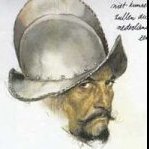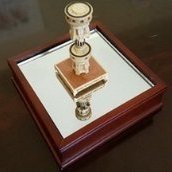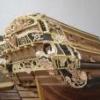-
Posts
3,867 -
Joined
-
Last visited
Reputation Activity
-
 KeithAug got a reaction from KORTES in Altair 1931 by KeithAug - FINISHED - Scale 1:32 - schooner
KeithAug got a reaction from KORTES in Altair 1931 by KeithAug - FINISHED - Scale 1:32 - schooner
More deck planking:-
I made a start on the planking which follows the contour of the deck edge. As explained previously these planks are much narrower. I made the planks .108 inch wide x 10 inch long which is 3.5 inch by 26 foot at full size.
It's probably worth posting a few images of the real thing at this point:-
I wanted the deck to be representative of the real thing but accepted that absolute accuracy wasn't quite achievable.
So here are a few images of progress to date:-
I was progressing well until my helper arrived and demanded some exercise!
-
 KeithAug got a reaction from KORTES in Altair 1931 by KeithAug - FINISHED - Scale 1:32 - schooner
KeithAug got a reaction from KORTES in Altair 1931 by KeithAug - FINISHED - Scale 1:32 - schooner
Today I had to find something to amuse myself as watching varnish dry isn't a very stimuating pass time (it has dried finally after 24 hours).
I thought I would have a go at making the propeller. I have not made one before and the fall back option was going to be to buy one. I don't however like buying fittings as it always feels like cheating.
This is what I did.
Firstly to make the blades I cut 3 identical strips of brass .040 inch thick. The 3 strips were fastened together using double sided tape as I intended cutting out all 3 blades at the same time. A paper template was fastened to the brass strips again using double sided tape . Confidence / experiences was low so I marked out 6 blades. The pin in one of the photo's gives an idea of scale.
I din't need the reserve set of 3 blades as the first lot turned out ok. The small peg at the bottom of each blade was to locate / fasten them in the hub.
The hub was turned on the lathe and 3 equi-spaced holes were drilled around the circumference to take the pegs on the blade. Each blade was given a slight curvature by bending it around a bar - using the vice to apply the pressure. The whole lot was then assembled and soldered together.
-
 KeithAug got a reaction from KORTES in Altair 1931 by KeithAug - FINISHED - Scale 1:32 - schooner
KeithAug got a reaction from KORTES in Altair 1931 by KeithAug - FINISHED - Scale 1:32 - schooner
I'm still watching varnish dry. The second and third coats have gone on and each dried in 10 hours. The 24 hours drying of the first coat must have had something to do with absorption of the varnish into the wood. Anyway it gave me time to finish off the prop shaft. I still have to make the "A" frame for supporting the rear bearing.
-
 KeithAug got a reaction from Nirvana in Altair 1931 by KeithAug - FINISHED - Scale 1:32 - schooner
KeithAug got a reaction from Nirvana in Altair 1931 by KeithAug - FINISHED - Scale 1:32 - schooner
Thanks Mark,
I used to do naps but Maisie is only 10 months and like your dog has banned all restful activity.
-
 KeithAug reacted to pete48 in Altair 1931 by KeithAug - FINISHED - Scale 1:32 - schooner
KeithAug reacted to pete48 in Altair 1931 by KeithAug - FINISHED - Scale 1:32 - schooner
Beautiful work Keith, It looks Amazing
Best Regards,
Pete
-
 KeithAug got a reaction from Tecko in Altair 1931 by KeithAug - FINISHED - Scale 1:32 - schooner
KeithAug got a reaction from Tecko in Altair 1931 by KeithAug - FINISHED - Scale 1:32 - schooner
I'm still watching varnish dry. The second and third coats have gone on and each dried in 10 hours. The 24 hours drying of the first coat must have had something to do with absorption of the varnish into the wood. Anyway it gave me time to finish off the prop shaft. I still have to make the "A" frame for supporting the rear bearing.
-
 KeithAug reacted to mtaylor in Altair 1931 by KeithAug - FINISHED - Scale 1:32 - schooner
KeithAug reacted to mtaylor in Altair 1931 by KeithAug - FINISHED - Scale 1:32 - schooner
A beautiful prop there, Keith. Nice work, indeed. Nothing wrong with watching paint/varnish dry. I do it early then read MSW and sometimes take a nap... although naps lately have been impossible due to dog seeing me doze off decides suddenly that it's play time.
-
 KeithAug got a reaction from KORTES in Altair 1931 by KeithAug - FINISHED - Scale 1:32 - schooner
KeithAug got a reaction from KORTES in Altair 1931 by KeithAug - FINISHED - Scale 1:32 - schooner
Slow progress but I did finish sanding the deck. I started with 120 grit emery cloth and removed all the plank thickness irregularities. I then used 400 grit wet and dry paper (used dry) to give a silky smooth finish. I used a damp cloth wiped over the deck to raise the nap and when dry I again used the 400 grit wet and dry. I repeated this twice.
I also sorted out the stern planking detail.
Time is drawing near when I will need to address the bulwarks so I decided to mount the plank required for inverted handling of the hull. To protect the deck rubber pads are attached to the bearers where they bolt to the hull. The plank is mounted parallel to the waterline so that the setting out of hull details (portholes etc) will be easier later on.
Having completed the deck sanding I wanted to protect the deck from workshop grime. I decided to give it a few coats of satin finish varnish. I need to glue ribs etc to the deck edge once the bulwarks are in place so I masked the deck edge mahogany planks so that gluing would not be a problem at a later stage. The photos were taken with the 1st coat of varnish still wet.
-
 KeithAug got a reaction from Nirvana in Altair 1931 by KeithAug - FINISHED - Scale 1:32 - schooner
KeithAug got a reaction from Nirvana in Altair 1931 by KeithAug - FINISHED - Scale 1:32 - schooner
More deck planking:-
I made a start on the planking which follows the contour of the deck edge. As explained previously these planks are much narrower. I made the planks .108 inch wide x 10 inch long which is 3.5 inch by 26 foot at full size.
It's probably worth posting a few images of the real thing at this point:-
I wanted the deck to be representative of the real thing but accepted that absolute accuracy wasn't quite achievable.
So here are a few images of progress to date:-
I was progressing well until my helper arrived and demanded some exercise!
-
 KeithAug got a reaction from KORTES in Altair 1931 by KeithAug - FINISHED - Scale 1:32 - schooner
KeithAug got a reaction from KORTES in Altair 1931 by KeithAug - FINISHED - Scale 1:32 - schooner
Starting the deck planking:-
I decided to make the deck planking .045 inch thick. This is thicker than the previous build (Endeavour) which was circa .030 thick. The additional thickness should make the caulking easier.
The mahogany deck edge planks were glued in place taking great care to make sure they were equidistant from the centre line. It's really easy for the deck planking to become unsymmetrical about the centre line and this can look pretty bad.
I wanted something that looked like teak for the deck planks and the nearest thing I had were slats recovered from a broken wooden venetian blind. The deck planking is a bit unusual in design in that the centre line planks on the fore deck are greater in number than over the remainder of the deck. The centre line planks are also wider than the other deck planks. I decided to go for a width of 0.188 inch for the centre line planks which equates to a scale width of 6 inch.
I decided to caulk between the planks using .008 inch thick black card. This equates to a thickness of 1/4 inch which is about right fro deck caulking.
The caulking was accurately cut into strips .045 inch wide using a set up on the mill. This consists of a MDF board clamped to the mill table with a steel bar clamped into the chuck to form a guide. With the card taped to the MDF the steel bar is positioned a couple of thou above the card and this forms the back stop for the set square. The mill table is then indexed in .045 inch steps and at each step a strip is cut from the card using a craft knife.
The centre line planks are then glued in place - making sure they are symmetrical about the centre line. In the photos below you can see one of the caulking strips laid on the deck and the tail of one of the installed strips.
The centre line planks are now complete but at this stage not sanded.
The caulking effect looks pretty good.
-
 KeithAug got a reaction from Tecko in Altair 1931 by KeithAug - FINISHED - Scale 1:32 - schooner
KeithAug got a reaction from Tecko in Altair 1931 by KeithAug - FINISHED - Scale 1:32 - schooner
Thanks Pete
I stayed at Coeur d'Alene once on the way to visit the Scablands and Glacier NP. A nice part of the world.
Progress of a different kind!
Having glued the deck in place and strengthened the areas unsupported by frames (g clamps in photo), I thought I had better take stock.
For the deck edge planks I needed to cut .040" x .130" mahogany strips from a 40"x12"x7/8" former table top. This involved planing and sawing operations on my full size wood machines as well as sawing on the Byrnes saw using TCT and slitting saw blades. Multiple operations and setting on different machines is always something I am inclined to put off. This instance was no different and I found myself looking for something else to do. My diversion project started out as cleaning up the workshop (photos attached) but very quickly expanded into clearing out my tool draws. I set myself the challenge of throwing out all the tools that I couldn't remember having used in the last 20 years. It was quite a haul but I failed with a few items that I thought might come in useful some day!!! They will probably be thrown out by the kids when they come to sort out my affairs in another 20 years time. The up side though is that I discovered stuff that would be useful if I had only remembered that I had it.
Having exhausted all my diversionary jobs I made the 6 deck edge planks, yawn!
I have a question for all you experienced posters. I see that when you sign off your posts you frequently attach reference to all your past, ongoing an future builds. I assume that you don't type this stuff out every time and that somehow you have set it up automatically. How do you do this please?
Keith
-
 KeithAug got a reaction from KORTES in Altair 1931 by KeithAug - FINISHED - Scale 1:32 - schooner
KeithAug got a reaction from KORTES in Altair 1931 by KeithAug - FINISHED - Scale 1:32 - schooner
Removal of up stands and a start on the deck:-
I had part cut the frames at deck level so removal of the up-stands wasn't a difficult process. I started by hand cutting but soon abandoned this in favour of a recently acquired multi tool fitted with a plunge blade. It worked a treat and I wonder why I hadn't bought one ages ago. I sanded the frames until I was comfortable with the deck profile which is concave bow to stern and convex across the beam. I used one of the left over planks laid across the frames to test the deck shape.
I decided to make the sub deck from 1/16 inch ply. Having cut a rectangular piece large enough to cover the hull I laid one of the long edges on the centre line of the hull and marked the position of the frames. I then drew the frame positions across the ply.
Having established the frame positions I used dividers to transfer the shapes of the deck cut outs from the plans on to the plywood.
Again using dividers I transferred the width of the hull on to the plywood at each frame position. The frames width dimensions were taken from the actual hull and not the plans.
I then used pins to give reference points against which a plank could be bent enabling the deck edge profile to be marked.
Having marked the deck profile I temporarily attached the plywood to the hull along the centre line.
I then marked the hull profile on the underside of the plywood using the hull as a template - thus checking the accuracy of the deck profile previously drawn. All was well.
Keith
-
 KeithAug got a reaction from Tecko in Altair 1931 by KeithAug - FINISHED - Scale 1:32 - schooner
KeithAug got a reaction from Tecko in Altair 1931 by KeithAug - FINISHED - Scale 1:32 - schooner
Today I had to find something to amuse myself as watching varnish dry isn't a very stimuating pass time (it has dried finally after 24 hours).
I thought I would have a go at making the propeller. I have not made one before and the fall back option was going to be to buy one. I don't however like buying fittings as it always feels like cheating.
This is what I did.
Firstly to make the blades I cut 3 identical strips of brass .040 inch thick. The 3 strips were fastened together using double sided tape as I intended cutting out all 3 blades at the same time. A paper template was fastened to the brass strips again using double sided tape . Confidence / experiences was low so I marked out 6 blades. The pin in one of the photo's gives an idea of scale.
I din't need the reserve set of 3 blades as the first lot turned out ok. The small peg at the bottom of each blade was to locate / fasten them in the hub.
The hub was turned on the lathe and 3 equi-spaced holes were drilled around the circumference to take the pegs on the blade. Each blade was given a slight curvature by bending it around a bar - using the vice to apply the pressure. The whole lot was then assembled and soldered together.
-
 KeithAug got a reaction from Nirvana in Altair 1931 by KeithAug - FINISHED - Scale 1:32 - schooner
KeithAug got a reaction from Nirvana in Altair 1931 by KeithAug - FINISHED - Scale 1:32 - schooner
Today I had to find something to amuse myself as watching varnish dry isn't a very stimuating pass time (it has dried finally after 24 hours).
I thought I would have a go at making the propeller. I have not made one before and the fall back option was going to be to buy one. I don't however like buying fittings as it always feels like cheating.
This is what I did.
Firstly to make the blades I cut 3 identical strips of brass .040 inch thick. The 3 strips were fastened together using double sided tape as I intended cutting out all 3 blades at the same time. A paper template was fastened to the brass strips again using double sided tape . Confidence / experiences was low so I marked out 6 blades. The pin in one of the photo's gives an idea of scale.
I din't need the reserve set of 3 blades as the first lot turned out ok. The small peg at the bottom of each blade was to locate / fasten them in the hub.
The hub was turned on the lathe and 3 equi-spaced holes were drilled around the circumference to take the pegs on the blade. Each blade was given a slight curvature by bending it around a bar - using the vice to apply the pressure. The whole lot was then assembled and soldered together.
-
 KeithAug got a reaction from Nirvana in Altair 1931 by KeithAug - FINISHED - Scale 1:32 - schooner
KeithAug got a reaction from Nirvana in Altair 1931 by KeithAug - FINISHED - Scale 1:32 - schooner
Thanks Mark - I'll try wipe on poly on the hull.
Hello Bedford - As you say it may be the wood. If I left the deck untreated I be constantly annoyed with family and friends when they pawed it. Hopefully the miniature crews deck boots will cope!
-
 KeithAug reacted to mtaylor in Altair 1931 by KeithAug - FINISHED - Scale 1:32 - schooner
KeithAug reacted to mtaylor in Altair 1931 by KeithAug - FINISHED - Scale 1:32 - schooner
Keith,
I've been using Wipe-on-Poly lately but in the past I used spray on. I've not tried any of shellacs or varnishes.
-
 KeithAug reacted to pete48 in Altair 1931 by KeithAug - FINISHED - Scale 1:32 - schooner
KeithAug reacted to pete48 in Altair 1931 by KeithAug - FINISHED - Scale 1:32 - schooner
Hi Keith, I could not agree more with everyone, Beautiful deck
Best Regards,
Pete
-
 KeithAug reacted to michael mott in Altair 1931 by KeithAug - FINISHED - Scale 1:32 - schooner
KeithAug reacted to michael mott in Altair 1931 by KeithAug - FINISHED - Scale 1:32 - schooner
Keith your deck looks super.
Michael
-
 KeithAug reacted to pete48 in Altair 1931 by KeithAug - FINISHED - Scale 1:32 - schooner
KeithAug reacted to pete48 in Altair 1931 by KeithAug - FINISHED - Scale 1:32 - schooner
Wow Keith, You have been busy, The Deck looks Fantastic, Well done
Best Regards,
Pete
-
 KeithAug reacted to michael mott in Altair 1931 by KeithAug - FINISHED - Scale 1:32 - schooner
KeithAug reacted to michael mott in Altair 1931 by KeithAug - FINISHED - Scale 1:32 - schooner
I am amazed at how fast you put that deck planking on, it looks good.
Michael
-
 KeithAug reacted to Bedford in Altair 1931 by KeithAug - FINISHED - Scale 1:32 - schooner
KeithAug reacted to Bedford in Altair 1931 by KeithAug - FINISHED - Scale 1:32 - schooner
I have noticed that some types of timber seem to make the varnish take longer to dry.
On a side note, I varnish my decks too but in reality we should leave them bare if we want to be accurate.
-
 KeithAug reacted to pete48 in Altair 1931 by KeithAug - FINISHED - Scale 1:32 - schooner
KeithAug reacted to pete48 in Altair 1931 by KeithAug - FINISHED - Scale 1:32 - schooner
Hi Mark, I have been using Epifanes varnish with good success ( it does take about 10 hours in between coats )
Best Regards,
Pete
-
 KeithAug got a reaction from Mfelinger in Altair 1931 by KeithAug - FINISHED - Scale 1:32 - schooner
KeithAug got a reaction from Mfelinger in Altair 1931 by KeithAug - FINISHED - Scale 1:32 - schooner
Today I had to find something to amuse myself as watching varnish dry isn't a very stimuating pass time (it has dried finally after 24 hours).
I thought I would have a go at making the propeller. I have not made one before and the fall back option was going to be to buy one. I don't however like buying fittings as it always feels like cheating.
This is what I did.
Firstly to make the blades I cut 3 identical strips of brass .040 inch thick. The 3 strips were fastened together using double sided tape as I intended cutting out all 3 blades at the same time. A paper template was fastened to the brass strips again using double sided tape . Confidence / experiences was low so I marked out 6 blades. The pin in one of the photo's gives an idea of scale.
I din't need the reserve set of 3 blades as the first lot turned out ok. The small peg at the bottom of each blade was to locate / fasten them in the hub.
The hub was turned on the lathe and 3 equi-spaced holes were drilled around the circumference to take the pegs on the blade. Each blade was given a slight curvature by bending it around a bar - using the vice to apply the pressure. The whole lot was then assembled and soldered together.
-
 KeithAug got a reaction from Nirvana in Altair 1931 by KeithAug - FINISHED - Scale 1:32 - schooner
KeithAug got a reaction from Nirvana in Altair 1931 by KeithAug - FINISHED - Scale 1:32 - schooner
Mark / Pete - thank you. The deck varnish is still tacky some 18 hours after application so I don't think I am going to be making much progress today. Modern oil based varnishes don't seem to dry as quickly as they seemed to when I was younger. I keep thinking I should try water based varnishes which claim to dry much quicker. I wonder what you all use?
-
 KeithAug got a reaction from cabrapente in Altair 1931 by KeithAug - FINISHED - Scale 1:32 - schooner
KeithAug got a reaction from cabrapente in Altair 1931 by KeithAug - FINISHED - Scale 1:32 - schooner
Slow progress but I did finish sanding the deck. I started with 120 grit emery cloth and removed all the plank thickness irregularities. I then used 400 grit wet and dry paper (used dry) to give a silky smooth finish. I used a damp cloth wiped over the deck to raise the nap and when dry I again used the 400 grit wet and dry. I repeated this twice.
I also sorted out the stern planking detail.
Time is drawing near when I will need to address the bulwarks so I decided to mount the plank required for inverted handling of the hull. To protect the deck rubber pads are attached to the bearers where they bolt to the hull. The plank is mounted parallel to the waterline so that the setting out of hull details (portholes etc) will be easier later on.
Having completed the deck sanding I wanted to protect the deck from workshop grime. I decided to give it a few coats of satin finish varnish. I need to glue ribs etc to the deck edge once the bulwarks are in place so I masked the deck edge mahogany planks so that gluing would not be a problem at a later stage. The photos were taken with the 1st coat of varnish still wet.







